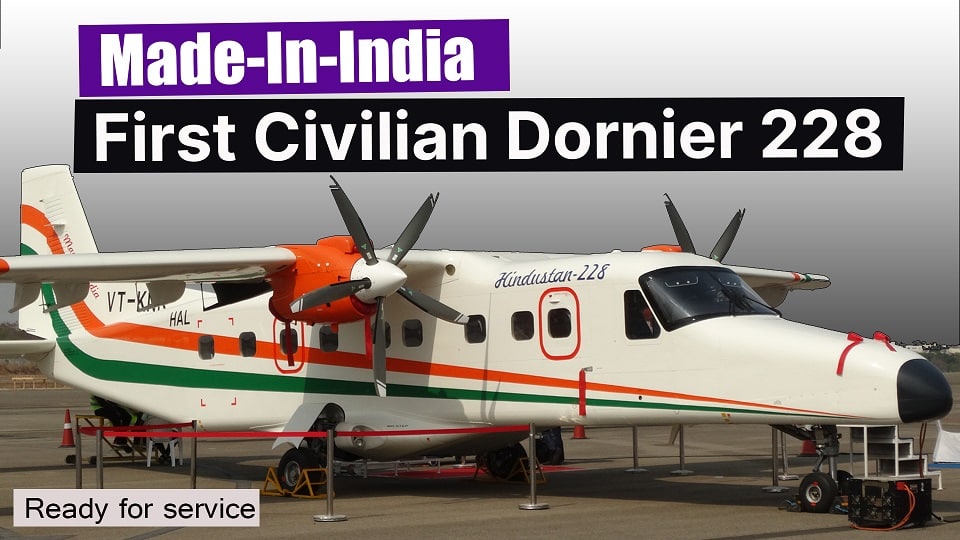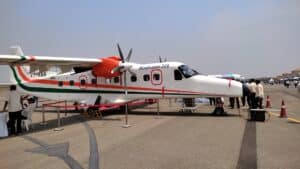Aviation
First civilian version of Dornier 228 : Features , Seats, Range and Speed

In this article we going to check out Indian Built Aircraft Dornier 228 which is displayed at Wings India. The aircraft built under production license of Dornier company.
It is 19 seater aircraft is a highly versatile and multi-purpose light transport aircraft. It has been developed specifically to meet the manifold requirements of utility and commuter transport, third level services and air-taxi operations, coast guard duties and maritime surveillance.
HAL has built 150 aircraft in its plant and now they are in service of in Indian Air force. In very shortly this aircraft may also join Indian commercial passengers service.
We saw airplanes up close during our visit to Wings India, and they are definitely up to the standard in terms of quality. Although the cockpit is basic and rather congested, the aircraft can nevertheless be flown with these attributes. Seats are arranged in a single aisle layout of one by one.
We gathered a few technical data regarding the aircraft, which will be flown by Indian air force crews and maintained by the Kanpur branch of HAL.
Alliance air Will induct two Made in India Dornier 228 aircraft to focus North East routes.
Alliance Air, which is Air India’s regional arm, signed a memorandum of understanding with plane manufacturer Hindustan Aeronautics Limited to dry lease the 19-seater planes.
The 19-seater non-pressurized Dornier 228 has a lavatory with an air-conditioned cabin capable of day & night operations. The light transport aircraft will facilitate regional connectivity and cater to solve the challenges of connecting hinterland areas of the country
JM Exclusive tour onboard the EMBRAER E195-E2 Demonstrator.
It has two crew members and can accommodate up to 19 passengers. This aircraft has a length of 54.4 feet, a wingspan of 55.8 feet, and a wing area of 340 square feet. Empty weight is around 3,900 kg, with a maximum take-off weight of 6,575 kg and a fuel capacity of 1,885 kg.
- Capacity: 19 pax
- Length: 16.56 m (54 ft 4 in)
- Wingspan: 16.97 m (55 ft 8 in)
- Height: 4.86 m (15 ft 11 in)
- Wing area: 32 m2 (340 sq ft)
- Airfoil: Do A-5
- Empty weight: 3,900 kg (8,598 lb)
- Max takeoff weight: 6,575 kg (14,495 lb)
- Fuel capacity: 1,885 kg (4,156 lb)
- Power plant: 2 × Honeywell TPE331-10 turboprop, 579 kW (776 shp) each
- Propellers: 5-bladed MT-Propeller, 2.5 m (8 ft 2 in) diameter fully-feathering constant-speed propellers.
What makes Dassaults Rafale fighter jet so special?
Performance
- Cruise speed: 413 km/h (257 mph, 223 kn)
- Stall speed: 137 km/h (85 mph, 74 kn)
- Range: 396 km (246 mi, 214 nmi) with 1,960 kg (4,321 lb) payload
- Ferry range: 2,363 km (1,468 mi, 1,276 nmi) with 547 kg (1,206 lb) payload
- Endurance: 10 hours
- Service ceiling: 7,620 m (25,000 ft)
- Fuel consumption: 0.945 kg/km (3.35 lb/mi) at 413 km/h (257 mph; 223 kn) IAS
- Take-off run: 792 m (2,600 ft) (MTOW, ISA, SL)
- Landing run: 451 m (1,480 ft) (MLW, ISA, SL)
Embraer displays cutting-edge E195-E2 at wings India
This aircraft is powered by two Honeywell TPE 331 turboprop engines, each with a power output of up to 579 kilowatts. It features a five-bladed MT propeller with a diameter of 8.2 feet.
Let’s talk about cruise speed. It has a top speed of 413 kilometers per hour and a stall speed of 137 kilometers per hour. It has a range of up to 396 kilometers and a payload of 1,960 kg. It has a flying time of up to 10 hours. It has up to 25,000 feet of service celling. At 413 km/h, it burns 0.945 kg of gasoline per kilometer.
This aircraft would cost around 50 corers in Indian rupees which is US$ 7.6 million

Aerospace
India is set to build a central command for the Air Traffic Control system, called ISHAN

India’s air traffic growth has led to increased responsibilities for air traffic control. The Airports Authority of India (AAI) is considering centralizing air traffic control for aircraft, dividing the country into four regions. The goal is to consolidate India’s segmented airspace into a single entity to improve air traffic management (ATM) efficiency, safety, and smoothness.
Recently, the AAI invited expressions of interest to develop a detailed project report for the Indian Single Sky Harmonized Air Traffic Management (ISHAN) initiative in Nagpur. Under this plan, air traffic controllers in Nagpur would handle domestic flights flying above 25,000 feet, eliminating the need for coordination among controllers in different regions.
For domestic regional flights operating above 25,000 feet, control would shift to the central command in Nagpur. This consolidation aims to enhance airline operations, increase flight handling capacity, and reduce congestion and flight times for passengers.
Currently, the AAI provides ATM services over Indian airspace and adjoining oceanic areas, covering over 2.8 million square nautical miles. This airspace is divided into four flight information regions (FIRs) in Delhi, Mumbai, Kolkata, and Chennai, along with a sub-FIR in Guwahati.
FIRs are responsible for providing air traffic services, including weather information, visibility, and search and rescue assistance. The proposed unification under the ISHAN initiative aligns with the projected growth of the aviation industry, which anticipates a doubling of domestic passenger traffic by 2030.
Aviation
Airbus is set to increase the production rate for the A350 as demand surges

Airbus SE is set to boost production of its advanced A350 widebody jet as it capitalizes on rising demand for long-distance travel and wide-body aircraft, amidst the ongoing crisis affecting its competitor Boeing due to issues with the B737 Max.
The surge in orders for Airbus’s A350 aircraft has instilled confidence in the company, prompting them to ramp up production rates. This move is particularly advantageous as Boeing continues to grapple with production quality issues surrounding its 787 and 777x aircraft.
In 2024 alone, Airbus has received 137 orders for the A350, signaling a need to expand manufacturing capabilities to meet customer demands. With 1,277 orders received and 592 aircraft delivered as of April 2024, Airbus is poised to fulfill pending deliveries efficiently.
The European aircraft manufacturer announced plans to increase production of A350 jets to 12 per month by 2028, surpassing earlier projections aiming for 10 per month by 2026. This decision was disclosed alongside the company’s first-quarter figures.
The Asian market is proving lucrative for the A350, with significant orders from airlines like Indigo and Air India, totaling nearly 70 aircraft commitments for the future. Meanwhile, Airbus is progressing with its A220 and A320 programs, aiming for a monthly production rate of 14 and 75 aircraft, respectively, by 2026. Additionally, the long-range A321XLR is anticipated to commence service in the third quarter of the current year.
In contrast, Boeing has been compelled to scale back production due to regulatory pressures aimed at enhancing factory processes. While Airbus anticipates a positive market outlook, Boeing continues to face challenges with FAA certification and quality approvals, resulting in ongoing delays for its 737 Max and 777x models.
Financially, Boeing reported a significant cash burn of $3.9 billion in the first quarter, leaving it with $7.5 billion in cash and short-term securities by the quarter’s end, down from $16 billion at the beginning of the year. Consequently, Boeing’s stock has plummeted by 38% in the year so far, contrasting with Airbus’s 14% gain, marking Boeing’s lowest performance in over a year.
For a full listing including details on customers and regions, as well as historical data for the previous year, go to the download section below.
- March 2024 deliveries: 63 deliveries to 32 customers
- March 2024 gross orders: 137
- 2024 deliveries to date: 142 deliveries to 45 customers
| Single-Aisle | A300/A310 | A330 | A340 | A350 | A380 | TOTAL | |
|---|---|---|---|---|---|---|---|
| Total Orders | 19470 | 816 | 1774 | 377 | 1277 | 251 | 23965 |
| Total Deliveries | 11705 | 816 | 1598 | 377 | 592 | 251 | 15339 |
| Aircraft in Operation | 11007 | 271 | 1482 | 202 | 591 | 234 | 13787 |
Aviation
All passengers killed in plane crash, after pilot let his children to control the plane

When boarding a plane, passengers entrust their safety to the skilled hands of the pilot. However, tragedy struck when one of the flight ended in disaster as all passengers lost their lives in a horrific plane crash.
In 1994, during a flight from Moscow to Hong Kong, tragedy struck as an Aeroflot relief pilot made a fateful decision. In a move that would have devastating consequences, the pilot invited his own children into the cockpit to play with the controls. Little did anyone know, this seemingly innocent gesture would lead to the loss of all 75 lives aboard the aircraft.
It was a seemingly innocent act that led to catastrophic results. The relief pilot, Mr. Kudrinsky, invited his two children, Yana, 12, and Eldar, 15, into the cockpit during the late hours of the night. Little did anyone know, this simple gesture would set off a chain of events that would end in tragedy.
Once in the cockpit, the children were allowed to sit in the captain’s chair and play with the controls, unaware that they should have been disabled as the plane was in autopilot mode.
Eldar, perhaps in a moment of curiosity or innocence, held the control column down for a mere 30 seconds. Yet, in those brief moments, the autopilot disengaged, thrusting the aircraft into manual control.
By the time the pilots regained their seats and attempted to regain control, it was too late. Despite their efforts to pull the plane out of a dive, they overcorrected, causing the flight to climb almost vertically, ultimately stalling it.
Final moment Flight 593 crash
In the final moments, as the pilots struggled to stabilize the aircraft, Flight 593 crashed into the Kuznetsk Alatau Mountain range in southern Russia, completely obliterating the plane and claiming the lives of everyone on board.
Investigations revealed a chilling truth: there was no evidence of technical failure. Instead, the crash was attributed to the unthinkable decision to allow inexperienced hands to manipulate the controls of a commercial aircraft.
The black box recording captured the harrowing sequence of events, providing a grim reminder of the human cost of a lapse in judgment. In just over two minutes, the lives of all on board were tragically short, leaving behind a legacy of sorrow and unanswered questions.























